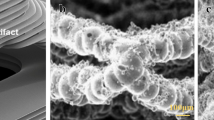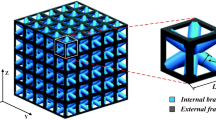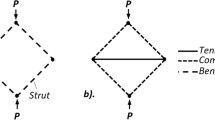Abstract
Lattice structure is a type of cellular structures which is made of interconnected struts. It attracts a great research interest, since it can achieve different desired properties for a broad spectrum of applications. To generate the geometric model of lattice structures with multiscale complexities is not an easy task for most existing conventional CAD software, especially when the number of cells or struts is very large. To solve this issue, an innovative hybrid geometric modeling method is proposed in this paper. This proposed method can be divided into three steps. They are lattice frame generation, construction of geometric functions, and voxelization. A detailed description of the algorithms and data structures used in each stage are provided in this paper. Several case studies are given at the end of this paper to illustrate the effectiveness and efficiency of the proposed method. In general, by integrating the advantages of several different geometric modeling methods, the proposed method not only provides an efficient and flexible way for designers to generate different types of lattice structures for desired properties, but also offers an interface between the geometric and simulation model of lattice structures. It further removes the barrier in the design and optimization of lattice structures with multiscale complexities.
Similar content being viewed by others
References
Tang Y, Zhao YF (2016) A survey of the design methods for additive manufacturing to improve functional performance. Rapid Prototyp J 22:569–590
Schaedler TA, Carter WB (2016) Architected cellular materials. Annu Rev Mater Res 46:187–210
Deshpande V, Fleck N, Ashby M (2001) Effective properties of the octet-truss lattice material. J Mech Phys Solids 49:1747–1769
Lehman J, Lakes R (2013) Stiff lattices with zero thermal expansion and enhanced stiffness via rib cross section optimization. Int J Mech Mater Des 9:213–225
Yang L, Cormier D, West H, Harrysson O, Knowlson K (2012) Non-stochastic Ti-6Al-4V foam structures with negative Poisson’s ratio. Mater Sci Eng A 558:579–585
Zhang Q, Han Y, Chen C, Lu T (2009) Ultralight X-type lattice sandwich structure (I): concept, fabrication and experimental characterization. Sci China, Ser E: Technol Sci 52:2147–2154
Heinl P, Müller L, Körner C, Singer RF, Müller FA (2008) Cellular Ti–6Al–4V structures with interconnected macro porosity for bone implants fabricated by selective electron beam melting. Acta Biomater 4:1536–1544
Bose S, Vahabzadeh S, Bandyopadhyay A (2013) Bone tissue engineering using 3D printing. Mater Today 16:496–504
Emmelmann C, Scheinemann P, Munsch M, Seyda V (2011) Laser additive manufacturing of modified implant surfaces with osseointegrative characteristics. Phys Procedia 12:375–384
Tang Y, Kurtz A, Zhao YF (2015) Bidirectional Evolutionary Structural Optimization (BESO) based design method for lattice structure to be fabricated by additive manufacturing. Comput Aided Des 69:91–101
Rosen DW (2007) Computer-aided design for additive manufacturing of cellular structures. Comput-Aided Des Appl 4:585–594
Ozdemir Z, Hernandez-Nava E, Tyas A, Warren JA, Fay SD, Goodall R, Todd I, Askes H (2016) Energy absorption in lattice structures in dynamics: experiments. Int J Impact Eng 89:49–61
Lehman J, Lakes RS (2014) Stiff, strong, zero thermal expansion lattices via material hierarchy. Compos Struct 107:654–663
Brooks H, Brigden K (2016) Design of conformal cooling layers with self-supporting lattices for additively manufactured tooling. Addit Manuf 11:16–22
Fantini M, Curto M, De Crescenzio F (2016) A method to design biomimetic scaffolds for bone tissue engineering based on Voronoi lattices. Virtual Phys Prototyp 11:77–90
Queheillalt DT, Wadley HN (2011) Hollow pyramidal lattice truss structures. Int J Mater Res 102:389–400
Wadley HN (2002) Cellular metals manufacturing. Adv Eng Mater 4:726–733
Tang Y, Zhao Y (2015), Lattice-skin structures design with orientation optimization, in: solid freeform fabrication, Austin, TX, pp 1378–1393
Tang Y, Dong G, Zhou Q, Zhao YF (2017) Lattice structure design and optimization with additive manufacturing constraints. IEEE Trans Autom Sci Eng 99:1–17
Liu C, Du Z, Zhang W, Zhu Y, Guo X (2017) Additive manufacturing-oriented design of graded lattice structures through explicit topology optimization. J Appl Mech 84(8):081008
Aremu AO, Brennan-Craddock JPJ, Panesar A, Ashcroft IA, Hague RJM, Wildman RD, Tuck C (2017) A voxel-based method of constructing and skinning conformal and functionally graded lattice structures suitable for additive manufacturing. Addit Manuf 13:1–13
Pasko A, Fryazinov O, Vilbrandt T, Fayolle P-A, Adzhiev V (2011) Procedural function-based modelling of volumetric microstructures. Graph Model 73:165–181
Fryazinov O, Vilbrandt T, Pasko A (2013) Multi-scale space-variant FRep cellular structures. Comput Aided Des 45:26–34
Wang H, Chen Y, Rosen DW (2005) A hybrid geometric modeling method for large scale conformal cellular structures. In: ASME 2005 Computers and Information in Engineering Conference, American Society of Mechanical Engineering, Long Beach, CA, pp 421–427
Vongbunyong S, Kara S (2017) Rapid generation of uniform cellular structure by using prefabricated unit cells. Int J Comput Integr Manuf 30(8):792–804
Kou XY, Tan ST (2007) Heterogeneous object modeling: a review. Comput Aided Des 39:284–301
Reinhart G, Teufelhart S (2011) Load-adapted design of generative manufactured lattice structures. Phys Procedia 12(Part A):385–392
Tang Y, Yang S, Zhao Y (2016) Design method for conformal lattice-skin structure fabricated by AM technologies. In: ASME 2016 International Design Engineering Technical Conferences and Computers and Information in Engineering Conference, American Society of Mechanical Engineers, Charlotte NC, PP:V01AT02A037
Pasko A, Adzhiev V, Sourin A, Savchenko V (1995) Function representation in geometric modeling: concepts, implementation and applications. Vis Comput 11:429–446
Singh JM, Narayanan P (2010) Real-time ray tracing of implicit surfaces on the GPU. IEEE Trans Vis Comput Graph 16:261–272
Ferry M, Paul Severin W, David W, Mark B, Fook Rhu O, Woon Shin C, Dietmar Werner H, Jan-Thorsten S (2011) CAD/CAM-assisted breast reconstruction. Biofabrication 3:034114
Vongbunyong S, Kara S (2016) Development of software tool for cellular structure integration for additive manufacturing. Procedia CIRP 48:489–494
Wang HV (2005) A unit cell approach for lightweight structure and compliant mechanism, Ph.D. Thesis, Georgia Institute Of Technology, Georgia, Atlanta
Whiteley M, White D, Benzley S, Blacker T (1996) Two and three-quarter dimensional meshing facilitators. Eng Comput 12:144–154
I. Altair Engineering (2013) HyperWorks user’s guide. Altair Engineering, Inc, pp 1682–1761
Owen SJ (1998) A survey of unstructured mesh generation technology. In Proceedings of the 7th International Meshing Roundtable, IMR 1998, Dearborn, Michigan, USA, pp 239–267
Si H (2015) TetGen, a Delaunay-based quality tetrahedral mesh generator. ACM Trans Math Softw 41:1–36
Lloyd S (1982) Least squares quantization in PCM. IEEE Trans Inf Theory 28:129–137
Du Q, Faber V, Gunzburger M (1999) Centroidal Voronoi tessellations: applications and algorithms. SIAM Rev 41:637–676
Gomes A, Voiculescu I, Jorge J, Wyvill B, Galbraith C (2009) Implicit curves and surfaces: mathematics, data structures and algorithms. Springer Science & Business Media, pp 07–40
Nishimura H, Hirai M, Kawai T, Kawata T, Shirakawa I, Omura K (1985) Object modeling by distribution function and a method of image generation. Trans Inst Electron Commun Eng Japan 68:718–725
Museth K (2013) VDB: high-resolution sparse volumes with dynamic topology. ACM Trans Graph 32:27
Museth K, Lait J, Johanson J, Budsberg J, Henderson R, Alden M, Cucka P, Hill D, Pearce A (2013) OpenVDB: an open-source data structure and toolkit for high-resolution volumes. In: ACM SIGGRAPH 2013 courses. Association for Computing Machinery, Anaheim, pp 19:1–19
Yushkevich PA, Piven J, Hazlett HC, Smith RG, Ho S, Gee JC, Gerig G (2006). User-guided 3D active contour segmentation of anatomical structures: significantly improved efficiency and reliability. Neuroimage 31(3):1116–1128
Cignoni P, Corsini M, Ranzuglia G (2008). Meshlab: an open-source 3d mesh processing system. In Eurographics Italian chapter conference, Salerno, Italy, 2008:129–136
Dong G, Tang Y, Zhao YF (2017) Simulation of elastic properties of solid-lattice hybrid structures fabricated by additive manufacturing. Procedia Manuf 10:760–770
Altair E Inc (2013) Optistruct user’s guide V12.0. Altair Engineering Inc, pp 03–20
Funding
This research work is supported by National Sciences and Engineering Research Council of Canada Discovery Grant RGPIN 436055-2013, China Scholarship Council (201306020032).
Author information
Authors and Affiliations
Corresponding author
Additional information
Publisher’s note
Springer Nature remains neutral with regard to jurisdictional claims in published maps and institutional affiliations.
Rights and permissions
About this article
Cite this article
Tang, Y., Dong, G. & Zhao, Y.F. A hybrid geometric modeling method for lattice structures fabricated by additive manufacturing. Int J Adv Manuf Technol 102, 4011–4030 (2019). https://doi.org/10.1007/s00170-019-03308-x
Received:
Accepted:
Published:
Issue Date:
DOI: https://doi.org/10.1007/s00170-019-03308-x




